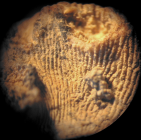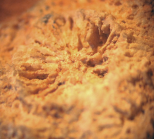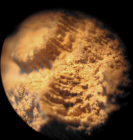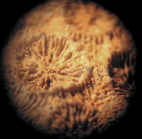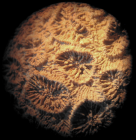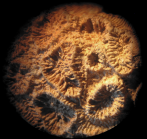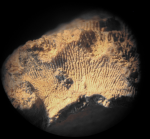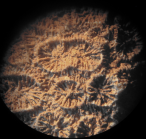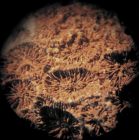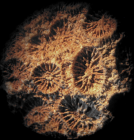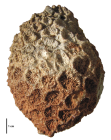
| Intro | | About | | Wiki | | Search traits | | Data explorer | | Literature | | Definitions | | Sources | | Webservices | | Statistics | | Feedback | | Editors | | Log in |
Scleractinia taxon detailsOvalastrea d'Orbigny, 1849 †
1439802 (urn:lsid:marinespecies.org:taxname:1439802)
accepted
Genus
Astrea caryophylloides Goldfuss, 1826 † accepted as Ovalastrea caryophylloides (Goldfuss, 1826) † (type by monotypy)
Ambiguastraea Alloiteau, 1952 † · unaccepted > junior subjective synonym
Favoidioseris Wells, 1933 † · unaccepted > junior subjective synonym
Ovalastraea d'Orbigny, 1849 † · unaccepted > misspelling - incorrect subsequent spelling
Plesioovalastraea Reig Oriol, 1994 † · unaccepted > junior subjective synonym
Pseudofavites Alloiteau, 1958 † · unaccepted > junior subjective synonym
Thalamocaenia d'Orbigny, 1850 † · unaccepted > junior subjective synonym
Thalamocoenia d'Orbigny, 1850 † · unaccepted > junior subjective synonym
marine,
fossil only
Orbigny, A. D. d'. (1849). Note sur des Polypiers fossiles. <em>Revue et Magasin de Zoologie, 2e sér.</em> 1: 526-538. [details]
Description Plocoid colony. Small round to large elongated or lobate outlined corallites. Co-occurrence of small round and di-centric...
Description Plocoid colony. Small round to large elongated or lobate outlined corallites. Co-occurrence of small round and di-centric clusters suggest the co-occurrence of intra and extracalicular modes of increase. Wall in relief, peritheca depressed. Radial elements are compact (or subcompact ?), straight to curved, costosepta. Rarely contratingent, often joined to the columella, or commonly free for the short septa. Septa with parallel edges. Septal structure probably pennular. Distal edge badly preserved, possibly moniliform. In corallite born by extracalicular increase, the radial symmetry of the septal apparatus is quickly obliterated by the development of the elongated columella and the bilateral symmetry of the calicular platform. Regularly dentate equal costae. Peritheca with confluent or not confluent costae and vesiculous dissepiments in between. Spongy columella. Synapticules present. Wall at least partly septothecal by enlargement of septa. [details]
Hoeksema, B. W.; Cairns, S. (2024). World List of Scleractinia. Ovalastrea d'Orbigny, 1849 †. Accessed at: https://marinespecies.org/scleractinia/aphia.php?p=taxdetails&id=1439802 on 2024-06-08
original description
Orbigny, A. D. d'. (1849). Note sur des Polypiers fossiles. <em>Revue et Magasin de Zoologie, 2e sér.</em> 1: 526-538. [details]
original description (of Favoidioseris Wells, 1933 †) Wells JW. (1933). Corals of the Cretaceous of the Atlantic and Gulf Coastal Plains and Western Interior of the United States. <em>Bulletins of American Paleontology,.</em> 18 (67): 85–292. [details] original description (of Ambiguastraea Alloiteau, 1952 †) Alloiteau J. (1952). Embranchement des Coelentérés. Madreporaires Post-Paleozoiques. <em>In: Piveteau J, ed. Traité de Paléontologie, Paris: Masson.</em> 539–684, pls. 1-10. [details] original description (of Pseudofavites Alloiteau, 1958 †) Alloiteau J. (1958). Monographie des madreporaires fossiles de Madagascar. <em>Annales Géologiques de Madagascar.</em> 25: 1-218, pls 1-38. [details] original description (of Plesioovalastraea Reig Oriol, 1994 †) Reig Oriol JM. (1994). Madreporarios Cretácicos de Cataluña. <em>. Privately published, Barcelona.</em> 60 pp. [details]  Present Present  Inaccurate Inaccurate  Introduced: alien Introduced: alien  Containing type locality Containing type locality
From editor or global species database
Comparison Ebrayia seems to be a very close genus for which we need to find more numerous well preserved specimens but lacks a really spongy columella. It is also the case for Ovalastreopsis.Ovalastrea has often been confused with Favia whose the septal structure is very different. [details]Description Plocoid colony. Small round to large elongated or lobate outlined corallites. Co-occurrence of small round and di-centric clusters suggest the co-occurrence of intra and extracalicular modes of increase. Wall in relief, peritheca depressed. Radial elements are compact (or subcompact ?), straight to curved, costosepta. Rarely contratingent, often joined to the columella, or commonly free for the short septa. Septa with parallel edges. Septal structure probably pennular. Distal edge badly preserved, possibly moniliform. In corallite born by extracalicular increase, the radial symmetry of the septal apparatus is quickly obliterated by the development of the elongated columella and the bilateral symmetry of the calicular platform. Regularly dentate equal costae. Peritheca with confluent or not confluent costae and vesiculous dissepiments in between. Spongy columella. Synapticules present. Wall at least partly septothecal by enlargement of septa. [details] Remark 9 Cretaceous nominal species are cited for Cretaceous (Löser 2002) of which some are common with the 14 nominal species cited in Jurassic. [details] |
